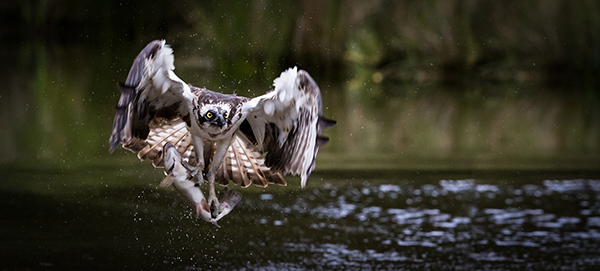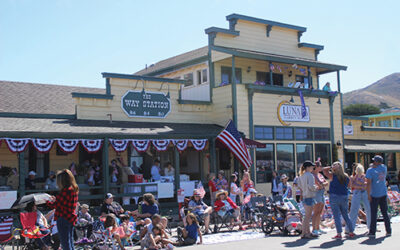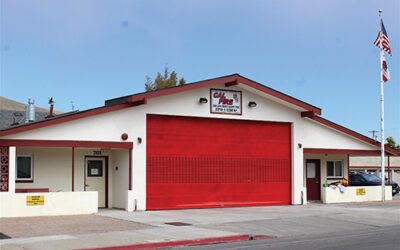An osprey catches a freshwater trout. Photo submitted
Despite the rain last Saturday, the Morro Coast Audubon Society completed a project hoping to entice ospreys to nest in Los Osos.
Two nesting platforms designed to appeal to the raptor birds were installed at Sweet Springs Nature Preserve located off of Ramona Ave and 4th St.
Over the past decade, increased numbers of osprey have appeared around the Morro Bay Estuary and have taken up year-round residence.
“Osprey really started showing up more, not just in the wintertime, but staying all summer, which is during nesting season,” said Judy Neuhauser, president of the Morro Coast Audubon Society. “Ospreys seem to be spreading out along the coast. We know they’re nesting in Southern California; we know they’re nesting up in the Bay Area. There aren’t any nesting between L.A. and San Francisco that we know of. It would be really wonderful to be able to establish a breeding population here.”
Ospreys like to nest higher up in anything from the tops of dead trees to atop power poles, and sometimes on buoys, chimneys, or other structures, preferably in sight a body of water that can provide the fish they eat.
“There’s been one [osprey] that has actually been bringing sticks into the mast of the Windwalker in Morro Bay, and looks like it’s trying to establish a nest,” Neuhauser said referencing a derelict boat tied up to the North T-Pier. “It’s not an appropriate nest site. It is too small and the sticks keep falling off.”
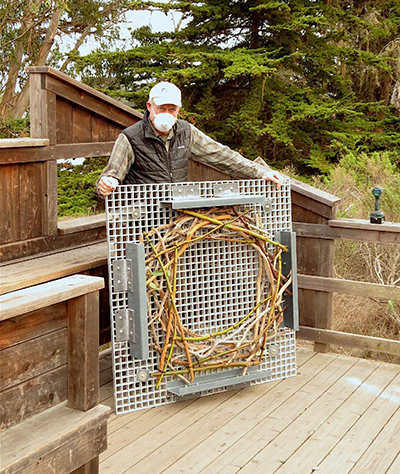
The raptors have been seen fishing in the Baywood Inlet, in other channels of the Estuary and along the Coast from Avila Beach to north of Cayucos. They have also taken to perching in trees at Sweet Springs over the past few years, which made experts believe that the site was potentially excellent for a nest platform. One was placed on a dead eucalyptus on the side of the pond side of the preserve and the other in a tree near the new bird overlook area.
On Giving Tuesday in 2020, Morro Coast Audubon sent out a fundraising call for help with purchasing materials and to help offset the costs of an arborist who had to climb and trim two trees at the preserve and install the platforms. Donors contributed more than $5,000, which should cover the costs of the current structures plus some of the funds needed to for a Coastal Development Permit for another nesting area in Morro Bay.
“We need to do the coastal development permit,” said Neuhauser. “We’ve been talking to city planning about a location and we think we have one that might work
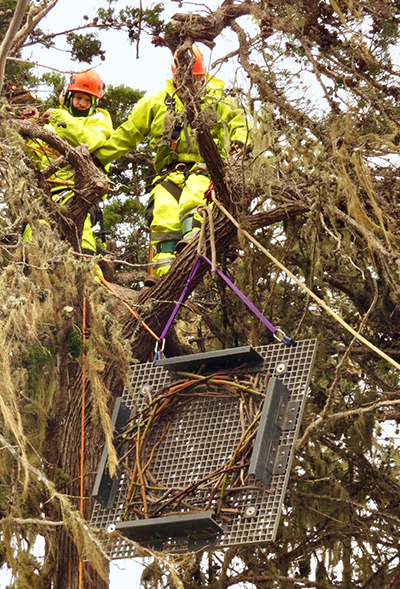
The platforms are made of a fiberglass composite making them relatively light weight and rust proof. Sticks and twigs were fastened to them before installation to create a “proto-nest” that is known to encourage osprey to examine and consequently utilize.
There is no guarantee that osprey will immediately occupy the nest platforms.
“It is a bit of a gamble,” said Dave Clendenen, Sweet Springs Nature Preserve manager and raptor expert. “It may be several years before osprey accept the offering. It may also be that one of the other raptors in the area will take over the nest platforms. We will provide an opportunity and await the results. We are confident that some raptor will eventually make use of these platforms to raise their young. At the volunteer work party a week ago, there were two osprey soaring overhead for quite a while, calling to each other. It really looked like courtship to me, so we are hopeful.”
All raptors are protected by state and federal regulations. It is illegal to capture or kill a raptor; possess a raptor (living or dead), or any pieces or parts of raptors, including feathers, without the proper permits from state governments and the federal U.S. Fish and Wildlife Service.
“They are a species of concern,” said Neuhauser. “They’re at the top of the food chain. If there’s anything going wrong with the food chain, they’re pretty heavily affected.”
For more information about the Morro Coast Audubon Society, go to https://www.morrocoastaudubon.org.

